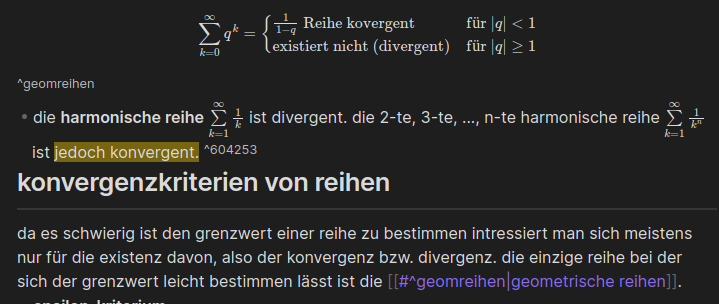I’m not able to reproduce any errors, but I wanted to comment on the fact that using $ ... $ is an inline syntax, so the blockId will refer to the entire paragraph, and you can’t have any text after the blockId.
If using $$ ... $$ you’ll get a proper math block, and it’ll also allow links to that block. Both if the blockId is directly after the block, and if it’s on a line of its own.
Try out the following in a block, switch to reading view and hover over the links at the bottom, and you’ll see the various references. (Note that I’ve mangled up the second and third equations with 2 and 3 as the numerator of the fraction.  )
)
The limit of geometrical series is: $\sum\limits_{k = 0}^\infty q^k = \frac{1}{1 - q}$^first
$$\sum\limits_{k = 0}^\infty q^k = \frac{2}{1 - q}$$ ^second
Another block...
$$
\sum\limits_{k = 0}^\infty q^k =
\frac{3}{1 - q}
$$
^third
[[#^first|First reference in a paragraph]]
[[#^second|Second reference after dollar signs]]
[[#^third|Third references on a line of its own]]
This example shows both proper blockId definitions, references within the same document using [[#^...]], and aliasing the link. I’ve also named the blockId’s for ease of reference. Be aware that if you rename them, you’re in charge of keeping them unique within this document.
So one variant of naming, which could be useful is doing something like:
$$\sum\limits_{k = 0}^\infty q^k = \frac{4}{1 - q}$$ ^geometric-series
... difficult to calculate, except for the [[#^geometric-series]]
Which will display like, when hovering over the link:
Do note that with custom names for the blockId, you need to use only numbers, letters and dashes. Otherwise, it’s not going to be recognised as a blockId.


